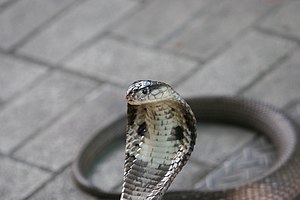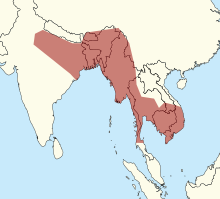Monocle cobra
| Monocle cobra | ||||||||||||
|---|---|---|---|---|---|---|---|---|---|---|---|---|

Monocle cobra |
||||||||||||
| Systematics | ||||||||||||
|
||||||||||||
| Scientific name | ||||||||||||
| Well kaouthia | ||||||||||||
| Lesson , 1831 |
The monocle cobra ( Naja kaouthia ) belongs to the genus of the real cobras ( Naja ) within the family of poisonous snakes ( Elapidae ).
features
The monocle cobra has a slim build. The head is slightly conical and only slightly separates from the neck. The total length of the snake is mostly between 100 and 150 cm, up to a maximum of 230 cm. The dorsal scales are solid brown, occasionally black. Even albino specimens are known. The ventral scales are grayish and lightly spotted. The monocle cobra has large scaled shields on the side and top of the head. It also has a fold of skin in the neck, which can be spread open to form a shield and shows a pseudo-eye on the back, the shape of which is often reminiscent of a monocle , from which the German trivial name can be traced back.
Way of life
The ground dwelling monocle cobra leads a crepuscular and nocturnal way of life. It feeds on frogs , lizards , birds , other snakes and small mammals that are killed with a poison bite. The species reproduces through oviparia (laying eggs). The female lays a clutch of 8 to 45 eggs in moist soil, piles of leaves, under stones or rotten wood. If the snake is threatened, it straightens its front body and spreads the neck shield.
Snake venom
As a poisonous snake, the monocle cobra has fixed, slightly elongated fangs in the front area of the upper jaw. Anatomically is considered Well kaouthia able to poison spewing , but reports can not be attributed with certainty of its kind giftspeiende Monokelkobras. It produces a highly potent toxin , which acts as a postsynaptic neurotoxin and also has strong tissue-destroying (cytotoxic) properties. After a bite, pain and swelling of the bitten limb appear very quickly, there is discoloration, blistering and local necrosis . Within a few minutes to hours after a bite, symptoms of the central nervous system such as general drowsiness and peripheral symptoms such as paralysis appear . In addition, vomiting, diarrhea , abdominal pain and headaches occur. The urea concentration increases and more protein is excreted in the urine ( proteinuria ). In extreme cases, such as an allergic shock, death can occur within a few minutes, but usually after around 17 to 24 hours due to respiratory paralysis. On the other hand, death can occur within 3 days from ventricular fibrillation. The lethality is untreated 1-10%. A poison bite from Naja kaouthia is treated by giving a monovalent (alternatively a polyvalent) antivenin as soon as possible , for which “Cobra antivenin” Thai Red Cross is available, and at least 24 hours of inpatient treatment and observation. The monocle cobra is widespread and does not shy away from being close to humans. It is responsible for many poisonous snakebites in its range; numerous deaths are recorded every year.
Taxonomy
The monocle cobra was first scientifically described in 1831 by the French naturalist René Primevère Lesson . Before it received its own species status , it was long considered a subspecies of the spectacled snake ( well, well ). Naja kaouthia subspecies are not recorded.
Occurrence
The monocle cobra is found in Southeast Asia from northern India , Bangladesh and southwest China to northern Malaysia . The original habitat are the tropical forests, especially in the lowlands. In general, however, it also inhabits plantations, rice fields and gardens. It is a strong cultural follower and often even invades human dwellings.
Terrariums
Well kaouthia is the most commonly kept species of cobra in captivity. Offspring in the terrarium are not uncommon. Due to the high toxicity, the keeping of this species should be reserved for specialists and zoological institutions.
Hazard and protection
The species is generally not threatened and the populations are stable. It is protected under Appendix B of the Washington Convention on Endangered Species .
supporting documents
Individual evidence
- ^ W. Wüster, RS Thorpe: Dentitional phenomena in cobras revisited: Spitting and fang structure in the asiatic species of Naja (Serpentes: Elapidae). In: Herpetologica. Volume 48, 1992, pp. 424-434.
- ^ University of Adelaide: Clinical Toxinology Resources, Naja laouthia . (Accessed August 31, 2019)
- ↑ Toxicological Department, Klinikum rechts der Isar, Munich: Genus Naja
- ↑ Girl dies after being ask in bed by cobra
- ↑ Naja kaouthia in The Reptile Database ; Retrieved January 6, 2011.
- ↑ WISIA
literature
- Mark O'Shea: Venomous Snakes - All species in the world in their habitats. Kosmos Verlag, 2006, ISBN 3-440-10619-5 .
- Dieter Schmidt: Atlas snakes. Nikol-Verlag, ISBN 978-3-86820-011-9 .
Web links
- Well kaouthia inthe IUCN 2013 Red List of Endangered Species . Posted by: Stuart, B. & Wogan, G, 2011. Retrieved January 7, 2014.

